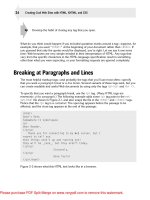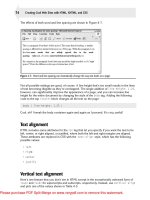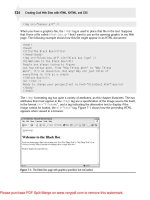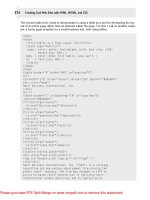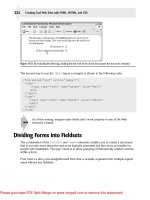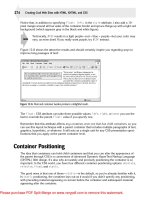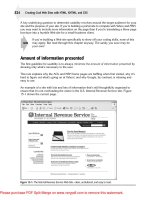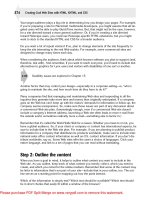New perspectives on creating web pages with HTML
Bạn đang xem bản rút gọn của tài liệu. Xem và tải ngay bản đầy đủ của tài liệu tại đây (1.29 MB, 58 trang )
Creating Web Pages with
HTML, 3e
Prepared by: C.
Hueckstaedt, Tutorial 1
1
XP
New Perspectives on Creating Web Pages
with HTML
Tutorial 1: Developing a Basic Web Page
Creating Web Pages with
HTML, 3e
Prepared by: C.
Hueckstaedt, Tutorial 1
2
XP
Tutorial Objectives
•
Explore the structure of the World Wide Web
•
Learn the basic principles of Web documents
•
Create a HTML document
•
View an HTML file using a Web browser
•
Use HTML tags for text, headings, paragraphs,
and lists
•
Insert character tags into an HTML document
Creating Web Pages with
HTML, 3e
Prepared by: C.
Hueckstaedt, Tutorial 1
3
XP
Tutorial Objectives Continued
•
Insert an inline graphic image into a HTML
document
•
Add special characters to an HTML document
•
Insert horizontal lines into an HTML document
Creating Web Pages with
HTML, 3e
Prepared by: C.
Hueckstaedt, Tutorial 1
4
XP
Introducing the World Wide Web
•
In order for computers to share resources
efficiently, they can be linked together in one of
the following structured networks:
–
linked within a local area network (LAN)
–
linked across a wide area network (WAN)
•
Networks are very useful, their use led to a
“network of networks” called the Internet.
Creating Web Pages with
HTML, 3e
Prepared by: C.
Hueckstaedt, Tutorial 1
5
XP
The Internet
•
The Internet consists of millions of interconnected
computers that enable users to communicate and
share information.
•
Many Internet tools required users to master an
array of terms, acronyms, and commands before
they could navigate the Internet.
•
The World Wide Web was developed to make the
Internet easier to use and give quick access to
users.
Creating Web Pages with
HTML, 3e
Prepared by: C.
Hueckstaedt, Tutorial 1
6
XP
Structure of the Internet
This figure shows the physical structure of the Internet, which uses fiber-optic cables,
satellites, phone lines, and other telecommunications media to send data back and forth.
Creating Web Pages with
HTML, 3e
Prepared by: C.
Hueckstaedt, Tutorial 1
7
XP
The Development of the
World Wide Web
•
In 1989, Timothy Berners-Lee and other
researchers at the CERN nuclear research facility,
laid the foundation of the World Wide Web, or the
Web.
–
created an information system that would make it easy
for researchers to locate and share data
–
required minimal training and support
–
developed a system of hypertext documents, electronic
files that contain elements that you can easily select
Creating Web Pages with
HTML, 3e
Prepared by: C.
Hueckstaedt, Tutorial 1
8
XP
Hypertext Documents
•
Hypertext offers a better way of locating
information.
•
When you read a book, you follow a linear
progression, reading one page after another.
•
With hypertext, you progress through pages in
whatever way is best suited to you and your
objectives.
•
Hypertext lets you skip from one topic to another.
Creating Web Pages with
HTML, 3e
Prepared by: C.
Hueckstaedt, Tutorial 1
9
XP
Linear Versus Hypertext Documents
This figure shows how topics can be related in a hypertext fashion,
as opposed to a linear fashion.
Creating Web Pages with
HTML, 3e
Prepared by: C.
Hueckstaedt, Tutorial 1
10
XP
Hypertext Documents Continued
•
The key to hypertext is the use of links, which you
activate to move from one topic to another.
–
a link can open a document on a computer anywhere in
the world
•
Hypertext has become the dominate method of
sharing and retrieving information on the Internet,
becoming known as the World Wide Web, or the
Web.
•
Documents on the Web are known as Web pages.
Creating Web Pages with
HTML, 3e
Prepared by: C.
Hueckstaedt, Tutorial 1
11
XP
Web Pages and Web Browsers
•
A Web page is stored on a Web server, which
makes the page available to users of the Web.
•
To view a Web page, the user runs a Web
browser, a software program that retrieves the
page and displays it.
•
A Web browser can either be text-based, or
graphical.
Creating Web Pages with
HTML, 3e
Prepared by: C.
Hueckstaedt, Tutorial 1
12
XP
Using a Browser to View a Web
Document on a Server
This figure shows to view web pages, the user runs a Web browser,
a software program that retrieves the page and displays it.
Creating Web Pages with
HTML, 3e
Prepared by: C.
Hueckstaedt, Tutorial 1
13
XP
Internet Explorer and Netscape
•
The most common Web browsers available today
are:
–
Microsoft Internet Explorer
–
Netscape Navigator
Creating Web Pages with
HTML, 3e
Prepared by: C.
Hueckstaedt, Tutorial 1
14
XP
Web Page with Interesting Fonts,
Graphics, and Layout
This figure shows a Web page is
not only a source of information,
it can also be a work of art.
links
graphic image
The Web designer has a great
deal of control over the format of
the page.
interesting fonts
Creating Web Pages with
HTML, 3e
Prepared by: C.
Hueckstaedt, Tutorial 1
15
XP
HTML: The Language of the Web
•
Web pages are text files, written in a language
called Hypertext Markup Language or HTML.
•
A markup language is a language used to describe
the contact and format of documents.
•
HTML was developed from the Standard
Generalized Markup Language (SGML), a
language used for large-scale documents.
•
SGML proved to be cumbersome and difficult,
thus HTML was created.
Creating Web Pages with
HTML, 3e
Prepared by: C.
Hueckstaedt, Tutorial 1
16
XP
Hypertext Markup Language (HTML)
•
HTML allows Web authors to create documents that
can be displayed across different operating systems.
•
HTML code is easy to use, that even
nonprogrammers can learn to use it.
•
HTML describes the format of Web pages through
the use of tags.
–
it’s the job of the Web browser to interpret these tags and
render the text accordingly
Creating Web Pages with
HTML, 3e
Prepared by: C.
Hueckstaedt, Tutorial 1
17
XP
Versions of HTML
This figure presents a history of the various versions of HTML that have been
released by the World Wide Web Consortium (W3C).
Creating Web Pages with
HTML, 3e
Prepared by: C.
Hueckstaedt, Tutorial 1
18
XP
Hypertext Markup
Language (HTML) Continued
•
HTML has a set of rules, called syntax.
–
syntax are a set of standards or specifications developed
by a consortium of Web developers, programmers, and
authors called the World Wide Web Consortium (WC3)
•
HTML extensions have been added to support new
features, which have been adopted in subsequent sets
of standards released by the W3C.
–
these extensions have provided Web page authors with
more options
Creating Web Pages with
HTML, 3e
Prepared by: C.
Hueckstaedt, Tutorial 1
19
XP
Web Development
•
Web designers need to determine which browsers
and browser versions support their web pages.
•
In the future, Web development is focusing more
on XML (Extensible Markup Language) and
XHTML (Extensible HyperText Markup
Language) for developing document content.
–
XML combined with style sheets provides the same
functionality as HTML, but with greater flexibility
–
XHTML was designed to overcome some of the
problems with competing HTML standards
Creating Web Pages with
HTML, 3e
Prepared by: C.
Hueckstaedt, Tutorial 1
20
XP
Tools for Creating HTML Documents
•
HTML documents are text files, which a text editor
such as Windows NotePad can be used to create.
•
You can also use an HTML converter or an HTML
editor.
–
an HTML converter like Microsoft Word takes text
in one format and converts it to HTML code
–
an HTML editor helps you create an HTML file by
inserting HTML codes for you as you work
Creating Web Pages with
HTML, 3e
Prepared by: C.
Hueckstaedt, Tutorial 1
21
XP
Creating an HTML Document
heading 1
image
horizontal line
paragraph
list
bold and italic
text
heading 3
It’s always a
good idea to
plan the
appearance of
your Web page
before you start
writing code.
Creating Web Pages with
HTML, 3e
Prepared by: C.
Hueckstaedt, Tutorial 1
22
XP
HTML Syntax
•
Document content is what the users sees on the
page, such as headings and images.
•
Tags are the HTML codes that control the
appearance of the document content.
–
tag is the name of the HTML tag
–
attributes are properties of the tag
–
document content is actual content that appears in the
Web page
Creating Web Pages with
HTML, 3e
Prepared by: C.
Hueckstaedt, Tutorial 1
23
XP
HTML Tags
•
Tags can be one-sided or two-sided.
–
two-sided tags contain an opening tag <b> that tells the
browser to turn on a feature and apply it to the contact
that follows, and a closing tag </b> that turns off the
feature
–
one-sided tags are used to insert noncharacter data into
the Web page, such as a graphic image or video clip
<tag attribute>
•
Tags are not case sensitive. The current standard
is to display all tags in lowercase letters.
Creating Web Pages with
HTML, 3e
Prepared by: C.
Hueckstaedt, Tutorial 1
24
XP
Interpretation of the <H1> tag by
Different Browsers
This figure shows how three different browsers might interpret a line of HTML code.
Creating Web Pages with
HTML, 3e
Prepared by: C.
Hueckstaedt, Tutorial 1
25
XP
Initial HTML Tags in Notepad
Your text editor may not display the file extension
in the title bar. This is okay.
<title> tag contains
the Web page title
Page content will
go between the
<body> tags
<head> tag
contains
information about
the Web page
<html> tag
indicates that
this file is
written in
HTML

